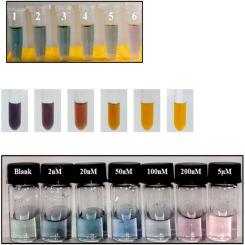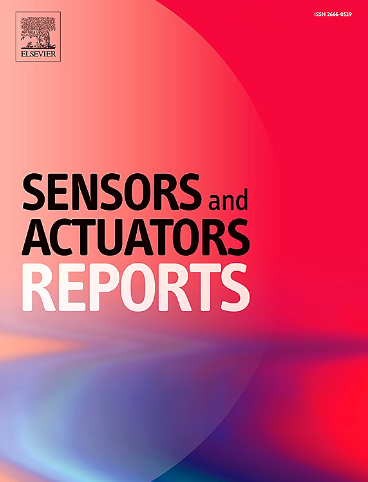A novel colorimetric lead ion detection method using lead-2′3-dimercaptosuccinic acid chelates to catalyze etching of gold nanostars
IF 7.6
Q1 BIOTECHNOLOGY & APPLIED MICROBIOLOGY
引用次数: 0
Abstract
Lead ions are an environmental pollutant and a threat to human health. Traditional methods for detecting lead ions suffer disadvantages such as being time-consuming and expensive, therefore there is a need to develop simpler and faster methods. We developed an optimized spectroscopic method to detect lead ions by first identifying a lead-specific chelator 2,3-dimercaptosuccinic acid (DMSA) which was screened using a novel biological screening system and verified by metal chromophore assays. Synthetic gold nanostars (GNSs) were explored for use as probes and we found that DMSA-Pb chelates catalyzed the etching of GNSs in solution resulting in a color change. We observed a change in the longitudinal local surface plasmon resonance (LSPR) peak of GNSs in the presence of DMSA-Pb which could be measured in subsequent experiments. The optimized etching reaction displayed strong sensitivity and selectivity for Pb2+ and achieved a detection limit of 2 nM less than 2 min, which is well below the safety threshold of Pb2+ in environmental water and food. The Pb2+ contents of rice, beans, milk, grapes, peaches, and cabbage were detected by the DMSA-Pb GNSs method and were consistent with those of inductively coupled plasma mass spectrometry (ICP-MS). Our study provides a novel and practical approach for rapid, safe, and cost-effective detection of lead ions.

采用铅-2′3-二巯基琥珀酸螯合物催化蚀刻纳米金,建立了一种新型比色铅离子检测方法
铅离子是一种环境污染物,对人类健康构成威胁。传统的铅离子检测方法存在费时、昂贵等缺点,因此需要开发更简单、更快速的方法。我们开发了一种优化的光谱方法来检测铅离子,首先鉴定了铅特异性螯合剂2,3-二巯基琥珀酸(DMSA),该螯合剂使用一种新的生物筛选系统进行筛选,并通过金属发色团试验进行验证。我们探索了合成金纳米星(GNSs)作为探针,我们发现DMSA-Pb螯合物催化GNSs在溶液中的蚀刻导致颜色变化。我们观察到在DMSA-Pb的存在下,gps的纵向局部表面等离子体共振(LSPR)峰发生了变化,这可以在后续的实验中测量。优化后的蚀刻反应对Pb2+具有较强的灵敏度和选择性,检测限为2 nM,小于2 min,远低于环境水和食品中Pb2+的安全阈值。采用DMSA-Pb GNSs法测定大米、豆类、牛奶、葡萄、桃子和白菜中Pb2+的含量,结果与电感耦合等离子体质谱(ICP-MS)测定结果一致。我们的研究为快速、安全、经济地检测铅离子提供了一种新颖实用的方法。
本文章由计算机程序翻译,如有差异,请以英文原文为准。
求助全文
约1分钟内获得全文
求助全文
来源期刊

Sensors and Actuators Reports
Multiple-
CiteScore
9.60
自引率
0.00%
发文量
60
审稿时长
49 days
期刊介绍:
Sensors and Actuators Reports is a peer-reviewed open access journal launched out from the Sensors and Actuators journal family. Sensors and Actuators Reports is dedicated to publishing new and original works in the field of all type of sensors and actuators, including bio-, chemical-, physical-, and nano- sensors and actuators, which demonstrates significant progress beyond the current state of the art. The journal regularly publishes original research papers, reviews, and short communications.
For research papers and short communications, the journal aims to publish the new and original work supported by experimental results and as such purely theoretical works are not accepted.
 求助内容:
求助内容: 应助结果提醒方式:
应助结果提醒方式:


